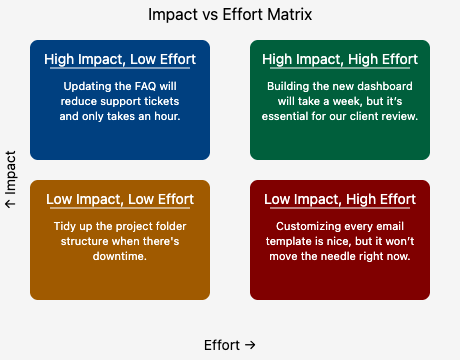Project success depends on focusing your team’s energy where it matters most. Prioritizing and protecting deadlines means making smart choices, communicating clearly, and keeping your project’s main goals front and center. Choose what will have the biggest impact and keep your team’s efforts aligned with what matters most—instead of trying to do everything at once.
Common scenarios include:
- Deciding which tasks are truly critical to hit your next milestone
- Explaining to stakeholders why some work is being deferred
- Adjusting plans quickly when priorities or deadlines shift
By the end of this lesson, you’ll be able to use the impact vs. effort framework to prioritize tasks and communicate changes effectively to protect project deadlines. To help you make these decisions, let’s look at a practical tool you can use with your team.
The impact vs. effort framework helps you decide what to tackle first:
- High impact, low effort: Do these first
- High impact, high effort: Plan and prioritize
- Low impact, low effort: Fit these in as time allows
- Low impact, high effort: Defer or drop
Here's how some tasks might fit into this framework:

This framework highlights that not all tasks are created equal. Effective project managers use it to quickly identify which work will have the biggest impact on project goals. In practice, this means:
- Tackling urgent, high-impact issues first (“Let’s resolve the login bug before we worry about design tweaks — users need access.”)
- Deferring or dropping lower-value tasks to protect critical milestones (“To stay on track for launch, we’ll hold off on customizing every email template for now.”)
- Explaining your reasoning so everyone stays aligned (“That’s a great idea, but to keep our timeline, we’ll revisit it after the launch.”)
By communicating these decisions clearly, you help your team stay focused and keep stakeholders in the loop. This approach ensures everyone is working on what will truly move the project forward.
Even the best plans can run into unexpected challenges — deadlines shift, priorities change, and new issues pop up. As a project lead, it’s important to:
- Regularly check progress and spot risks early
- Act quickly to reassign work or shift resources when needed
- Communicate changes transparently, explaining the “why” behind new priorities
When communicating changes, use clear and concise language. Always explain the reasoning behind your decisions to help your team and stakeholders understand the “why” and build trust and buy-in. This approach keeps everyone aligned and reassured that decisions are made with the project’s best interests in mind.
Here’s how this might sound in a real conversation:
- Jessica: Chris, I noticed we’re behind on the new dashboard, but the team is also spending time updating all the email templates. Do you think we should shift our focus?
- Chris: Good point, Jessica. The dashboard is critical for the client review, while the email updates can wait.
- Jessica: Agreed. Let’s pause the email template work and have everyone focus on the dashboard so we don’t risk missing the milestone.
- Chris: I’ll update the team and make sure everyone’s clear on the new priorities.
In this example, Jessica raises a concern and invites input, and together she and Chris quickly realign the team’s focus to protect a key deadline. They communicate the change clearly and explain the reasoning, helping everyone stay on track.
When you prioritize and protect deadlines this way, you help your team avoid burnout and keep your project’s most important goals within reach. You’ll use these strategies in the next practice session, where you’ll role-play making tough prioritization decisions and communicating changes to your team and stakeholders. Focus on applying the impact vs. effort framework and explaining your reasoning clearly.
